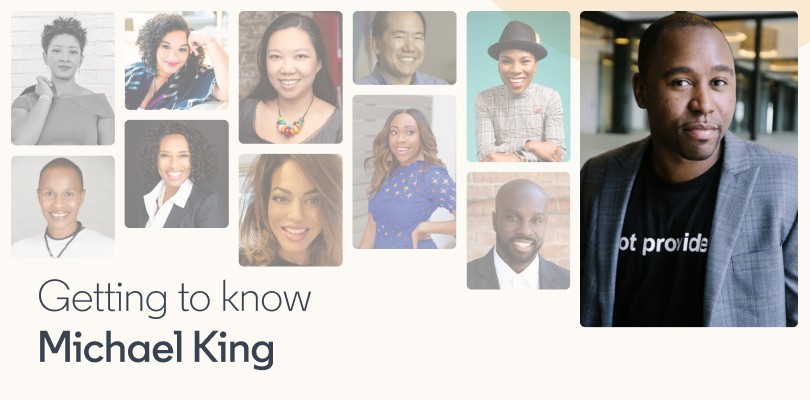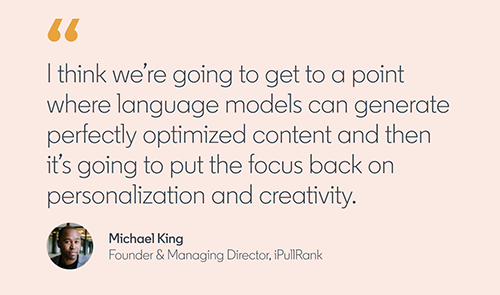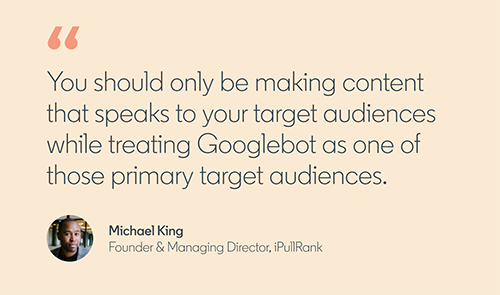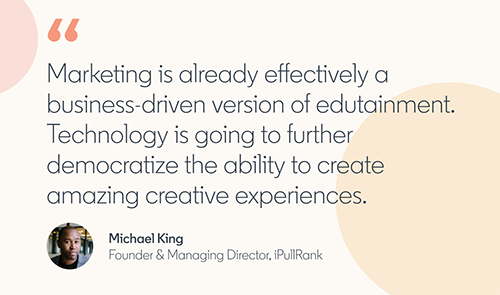Michael King: Do the Real and Uncomfortable Work
Marketing thought leader and SEO expert Michael King is in the midst of quite an impressive run these days.
Fresh off of being named a 2020 Search Marketer of the Year, Michael has a book coming out in early 2022 focused on demystifying the computer science behind SEO. As for the here and now, the Founder and Managing Director of iPullRank continues to plan, optimize, and create modern digital marketing campaigns sought out — and trusted — by Fortune 500 brands.
Michael leads his agency with a unique blend of content strategies and engineering skills — the kind of advanced thinking other professionals turn to for new methodologies and a competitive edge.
And while he’s leading the charge to apply technologies that exist today, Michael envisions even greater possibilities on the horizon with the explosion of language models. As he puts it, the merging of technology and science into computer advancements “is about to make the SEO world an even more interesting and competitive space.”
A serial entrepreneur at heart who likens the experience to the NBA Finals or the Super Bowl of business, Michael has been recognized as an expert in marketing by Forbes, is a globe-trotting speaker (and rapper!), and someone who truly inspires us as a marketer to watch.
In this in-depth and entertaining interview, we get right down to business with Michael about the exciting future of SEO (with advice for young search marketers), try our best to get him to rant about SEO misconceptions that just won’t die, and draw out his blunt advice for brands about their responsibilities, actions and direct impact in diversity, equality, and inclusion today.
LinkedIn: You focus a great deal on the merging of SEO with technology and science. What do you see as the most important innovations taking place today at that intersection?
Michael King: We’re just diving right into the deep end, huh?
I’d say the explosion of language models is the most interesting thing that’s happening in technology that is touching SEO right now. It’s giving us two new superpowers at scale as SEOs. One, the ability to understand language more effectively and two, the ability to generate viable copy with minimal human intervention.
You may have heard about how an AI called GPT-3 can write copy that’s good enough for major publications. Well, GPT-3 is a language model that people are using to automate writing that is virtually undetectable by a human reader. That language model is based on technology that Google’s AI team developed called “Transformers.” Transformers in-turn informed something called BERT that has changed how Google understands content. The open-source community has gotten a hold of these and has been building all types of amazing things around it.
All of these advancements in a computer’s ability to understand and generate natural language are about to make the SEO world an even more interesting and competitive space. People that are early adopters are going to build some very large moats around them very quickly. My team at iPullRank and I have had a lot of fun as of late playing with this stuff and coming up with bleeding-edge solutions for our clients to scale content that is actually useful to people across billions of pages. I love it because it allows us to free ourselves up to do more creative work while a language model can handle more of the mundane stuff.
I think we’re going to get to a point where language models can generate perfectly optimized content and then it’s going to put the focus back on personalization and creativity. That’s pretty exciting to me because it perfectly speaks to how we approach things from a right- and left-brained perspective.
LI: What is a prevalent misconception about SEO that just won't go away, and needs to?
Michael: Now I feel like you’re trying to get me to rant.
I’m torn between two. One is that SEO is “free” traffic. The other is that there is such a thing called “SEO content.”
Organic Search is not a free traffic channel. Rather, the cost of ranking well is baked into making the technical fixes to make your site accessible to search engines, creating content that resonates with your audience, and promoting that content to get the authority and ultimately visibility.
None of those things are free. Granted, if you do all those things right, or at least with SEO in mind from the beginning, then there is no additional cost to driving Organic Search traffic. However, the reality is that most people don’t, so there is a cost involved in going back and optimizing.
On the “SEO Content” point, many people haven’t kept up with progress made by Google in how it can understand content. So, they don’t know that the search engine has evolved beyond the times when you wrote content for robots and just repeated phrases over and over. You should only be making content that speaks to your target audiences while treating Googlebot as one of those primary target audiences.
LI: How would you advise an aspiring young search marketer to get rolling in the industry? Where should they concentrate their learning and development?
Michael: Admittedly, I have a bias towards building things and having actual hands-on experience. People that have actually built for the web tend to do better work than people who have just talked or written about building for the web. So, more than anything, I’d recommend that they build something and make it rank. They don’t have to build the next app or big media company, but I’d recommend that they start a blog or an e-commerce site. Set a goal related to SEO like sell X-amount of t-shirts or rank for a specific keyword and figure out what it takes to make it happen. You’ll learn far more that way and it will actually stick.
As far as where they should learn, I’d recommend starting with Moz’s Beginner’s Guide to SEO and Aleyda Solis’s LearningSEO.io. Aleyda’s site is an active project that curates the greatest materials from some of the best SEOs around.
LI: The last year has obviously been a turbulent one for society, with COVID lockdowns and civil unrest stemming from George Floyd's killing. What do you view as the biggest challenges, changes, or lessons of the past 12 months from a marketing standpoint?
Michael: Brands have power over culture and behavior. After all, brand messaging is the reason why people take coffee breaks and buy engagement rings. However, what we’ve seen in recent years is that the web and social media have redistributed the power and given the people the bullhorn and more collective control.
We’ve seen it with the #MeToo movement, we’re seeing it post-George Floyd, and we’re also seeing the AAPI community garnering support now that they have the megaphone.
I can only speak from the Black experience. And what I’m seeing is that the Overton Window has certainly shifted around what you’re allowed to be as a Black person in America. Generally, for Black people, it has historically been about how effective you are at conforming if you want to be successful. I, myself, have never been a code switcher. I have always been exactly who I am, but it has felt good for that to suddenly be accepted.
Bigger picture though, there has been a lot to unpack. We’ve watched how brands fall quickly into homogeny and risk-aversion with everyone creating the same commercial featuring somber pianos and messages about how their ketchup, car, or light bulb brand is “here for you” in these trying times.
I think that is part of the difficulty post-George Floyd. Marketing and advertising are done by committee and that often yields watered down and insincere messaging. We’ve quickly shifted from people of color being actively excluded from creative to everyone suddenly filling their commercials with Black women.
More than ever, brands need to have representation in the boardroom, up and down the organization, and across their strategic partnerships when they are making decisions. They also need to listen and act on the feedback from those folks, not just have them in the room. More importantly, brands need to default to communicating with sincerity and humanity when they want messages to resonate. Brands need to take the position of active listening first and building an ongoing dialogue with people of color rather than treating us as a special interest.
It’s not enough to showcase the intention toward diversity, equity, and inclusion. You have to show and prove because people are watching closely, and people have the power to change the conversation for you if your brand isn’t genuine.
LI: For fellow business leaders, what are the primary keys to increasing diversity and equity, in marketing broadly and more specifically within your corner of the profession?
Michael: There was a recent episode of the sitcom "Black-ish" where a cousin from the White side of Rainbow’s (the mixed-race wife) family was all riled up about supporting Black people in the wake of George Floyd. The cousin kept rattling off all these things that he was going to do to make the system change. At the climax of the episode, Andre (the Black husband) confronts the cousin and asks if he’s going to take his kids out of private school and put them into a public school to effect change. Of course, the cousin said no.
I offer that to say, diversity, equity, and inclusion are not just about other people and systems changing. It’s about individual change and making different decisions to proactively make space for those who have been historically excluded.
The primary key is that the changes you have to make to support DE&I initiatives will be uncomfortable, but you should still do them. They might be risky, but sharing your advantage with disadvantaged people inherently is. Sometimes it’s about hiring the LatinX candidate that does not have an Ivy League degree, when there’s a White candidate that does. Because you know what offsets pedigree? Opportunity. Sometimes it’s about hiring the black-owned business as a vendor even if you’re not sure they can scale. Because you know what helps with scale? Money. Sometimes it’s about using the pronouns that people request even if it makes you feel out of place. Because you know what helps with feeling out of place? Normalization.
It’s not just about hiring a Chief Diversity Officer to check the box. It’s about doing the real and uncomfortable work. It’s also about visibility.
I remember going to my first marketing conference and being enamored by the people that were speaking. However, it wasn’t until I saw a Black speaker named Wil Reynolds speak that I thought to myself “Oh, they let Black people do this too!” and while he was onstage, I pitched for my first speaking engagement. I ultimately got the slot, did a good job, and it created the snowball effect that created my career in thought leadership.
So, imagine if I went through that whole event and there wasn’t a speaker that looked like me. Now apply that same concept when someone is considering applying to your company and they don’t see diversity in leadership whether that is gender or race. They will feel excluded and they will feel more compelled to apply at a company that does have that diversity. Now apply that same concept to how you think about who is present in the content and creative that you’re putting out into the world as a marketer.
The major key is that we all need to proactively make space for underrepresented groups especially when it’s not the easy thing to do.
LI: What content is giving you life? (Or, what's the most impactful/memorable piece of content you've encountered recently?)
Michael: I’m working on my book, “The Science of SEO,” so, haven’t really had the time lately to consistently consume anything. I’m also one of those people that signs up for a bunch of mailing lists and never reads them. However, Tom Critchlow’s SEO MBA blog has been a refreshing series that has been triggering a lot of new thoughts on how my team and I can level up what we’re doing, how we frame it, and how we do it.
LI: How do you use LinkedIn to grow your network and influence as an authority on the topic of technical SEO?
Michael: Right now, LinkedIn is the channel with the most organic reach, so that inherently makes me want to be there. What’s more compelling is that people are very open to stories here. Twitter used to be my primary channel for pushing out content, but it’s all about trying to drop punchlines.
As a content creator, I find it especially compelling to move away from that and attempt to tell a relatable short story that makes someone want to click “read more” and react to what I’m looking to share.
For me, it’s not so much about always talking about technical SEO. That’s certainly a big part of my narrative, but it’s also about humanizing what it is we do and discussing other relatable things. For example, I shared a story about how my daughter was a flower girl in a wedding and she didn’t drop all of the flowers out of her basket before she got to the end of the aisle. I related the story to the workplace by explaining how it made me realize the need for training, process, and practice because you can never be sure what nuance that is obvious to you is not to someone else.
As a result, LinkedIn has encouraged me to do more video content. We’ve been posting a series of videos that I call “Rank and File” where I give SEO tips. Also, while I’m not really into artisanal talk radio (aka podcasting), one of the guys on my team, Jarrett Thomas, has had some success with a podcast that he does called Rankable. I’ve been on it a few times and he’s used it to expose us to more brands that otherwise would not have heard of iPullRank.
All in all, I think LinkedIn is a fantastic platform that allows you to shape the conversation around whatever it is you do. The more you showcase yourself to be signal over noise and the more value you put into it, the more value you get back from it.
LI: As you look ahead to the next couple of years in marketing, what energizes you most?
Michael: Right now, we are witnessing a very interesting confluence of media, entertainment, and technology. Every brand is or is becoming a publisher company and every publisher is a brand. That’s been reflected in every company having a blog, podcast, or an online TV show.
I’m excited to see how machine learning-driven technologies continue to play out and create new opportunities for media-minded marketers. Marketing is already effectively a business-driven version of edutainment. Technology is going to further democratize the ability to create amazing creative experiences. Last year, we made an animated movie about technical SEO called “Runtime.” I think we did a good job with limited resources and time. However, I think we’re going to see more brands level up in this area in the near future where we use things like DeepFake technologies to generate live action characters and make creative content that is cinematic quality. I’m excited for iPullRank to continue to take creative risks in leveraging these technologies to develop use cases in support of data-driven content strategies and redefine what technical marketing is.
LI: Any final thoughts?
Michael: Thanks for inviting me to be a part of the Marketers to Watch series. It has been an honor to be included amongst such a great group of people that are using their skills and voices to change the world through marketing.
It’s a very exciting time to be a digital marketer as the world is changing culturally, behaviorally, and technologically. At iPullRank, we’re deeply involved in driving these changes and executing marketing that capitalizes on new opportunities. Did I also mention that we’re actively looking for talented people of all types to join us?
I’d also love it if people would check out our Rankable podcast. We broadcast live right on LinkedIn. Also, feel free to get in touch with me if you have any questions about SEO, Content Strategy or technical marketing.
Is your LinkedIn feed feeling stagnant these days? Follow these 16 brilliant thinkers to add new voices. And to keep abreast of the latest marketing trends, subscribe to the LinkedIn Marketing Solutions blog.
Topics: Diversity Skill building and careers
Related articles








